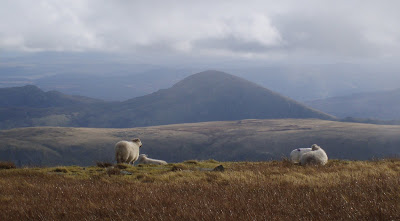In contrast the northern Carneddau are much more rarely frequented. The hills have a completely different character to their southern brethren; in place of steep ascents and bouldery summits are grassy slopes with more occasional rocky outcrops. The paths are less eroded and have only been reinforced by paving slab-wielding National Trust volunteers in a handful of places. Quite a few sturdy-looking ponies inhabit the lower reaches, and at the beginning of the walk we paused to watch several sheepdogs at work, herding their charges off the hill and down to the valley bottom.
We started our hike from a small car park near the end of a minor road leading south east from the village of Abergwyngregyn. Most people parking here do so for the brief trek to see the Aber Falls a couple of kilometres away; these waterfalls do indeed seem to be impressive, but alas it was too dark to properly appreciate their splendour by the time we reached them. Rather than crossing a nearby bridge and heading straight for the falls we instead continued along the road to its end where it turned into a gravel track. We quickly left this behind us, and freestyled our way up through patches of prickly gorse to the top of the first hill, the diminutive but still rather nice Foel Ganol. From this vantage point we could see across the Menai Straits to Anglesey looking one way, and to the cloud-swathed peaks that were our playground for the day in the other direction.
The ponies viewed us with a mixture of contempt and annoyance, clearly not impressed to have humans invading their space. We brushed off this unfriendly welcome however, and strode on, across Pen Bryn-Du and Carnedd y Ddelw. We ascended this latter well and truly enveloped in the clag; a minor annoyance, but not anything to get too worked up about as after all, we were in Wales and this is the sort of weather that Wales does best. Next up was the refreshingly-pronounceable Drum, where we stopped for a well-earned snack, followed by Foel Fras; a thoroughly respectable 942 m high and bearing the first trig point of the day.
It was at this summit that we came across our first fellow hiker, sheltered behind a wall and enthusiastically tucking into his sandwiches. There was also a scattering of sheep posing quite elegantly by the edge, providing perfect foreground interest for when the clag momentarily cleared:
Things were starting to get rather good. After a few minutes more walking in the grey the cloud rose again, lifting our spirits with it. The sky revealed itself to be a bright azure blue streaked with wispy white, the sun beat down with a strength belying the fact that it was almost winter, but best of all was the way in which the low clouds still remaining were gracefully decorating the flanks of the hills before us. By the time we reached the rocky rise of Garnedd Uchaf (recently renamed Garnedd Gwenllian after a Welsh princess who spent most of her time locked up in a Priory), the view was spectacular.
Our initial plan had been to use this walk as a gentle warm-up, and to descend over Llwytmor from Foel Fras and to be down by early afternoon. However we were hungry for more and hence had stayed up, continuing on to Garnedd Uchaf. It didn't take us very long once here to decide to extend the walk still further; after all Foel Grach was only a kilometre away and the view was so good that it would seem rude not to keep going. At Foel Grach a similar argument spurred us on to Carnedd Llewellyn, whose summit provided one of the best views I have ever seen in my life.
The clouds were positively caressing the mountains in front of us; pouring over the ridges like breakers on the sea. The grand figure of Snowdon stood proudly in the background, itself for once completely clear. The low afternoon sun illuminated the scene beautifully, catching the tops of the clouds and making them shine pearly white. I could have stayed and watched forever. Alas, the sun was descending rapidly and we had a long way to walk back to the car, and so we had to tear ourselves away.
We retraced our steps over Foel Grach, skirted past Garnedd Uchaf and moved on to Bera Bach. This impressive pile of rock was crying out to be scrambled over, but alas we had not the time, and so reluctantly passed it. The last hill of the day was the cairn-topped Drosgl, from which we could look back over the chains of now completely cloud-free mountains. There was no opportunity to linger so we headed down to the col, from where we used sheep tracks to make our way down to the valley bottom. Fortunately luck was with us, and we easily joined up with the wide tourist trail leading to the waterfall. It was now rather dark but we resisted getting out the head torches, preferring to let our eyes adjust naturally to the gloom. Before long we were back at the car, looking forward to sating our post-walk hunger for tea and cakes.





